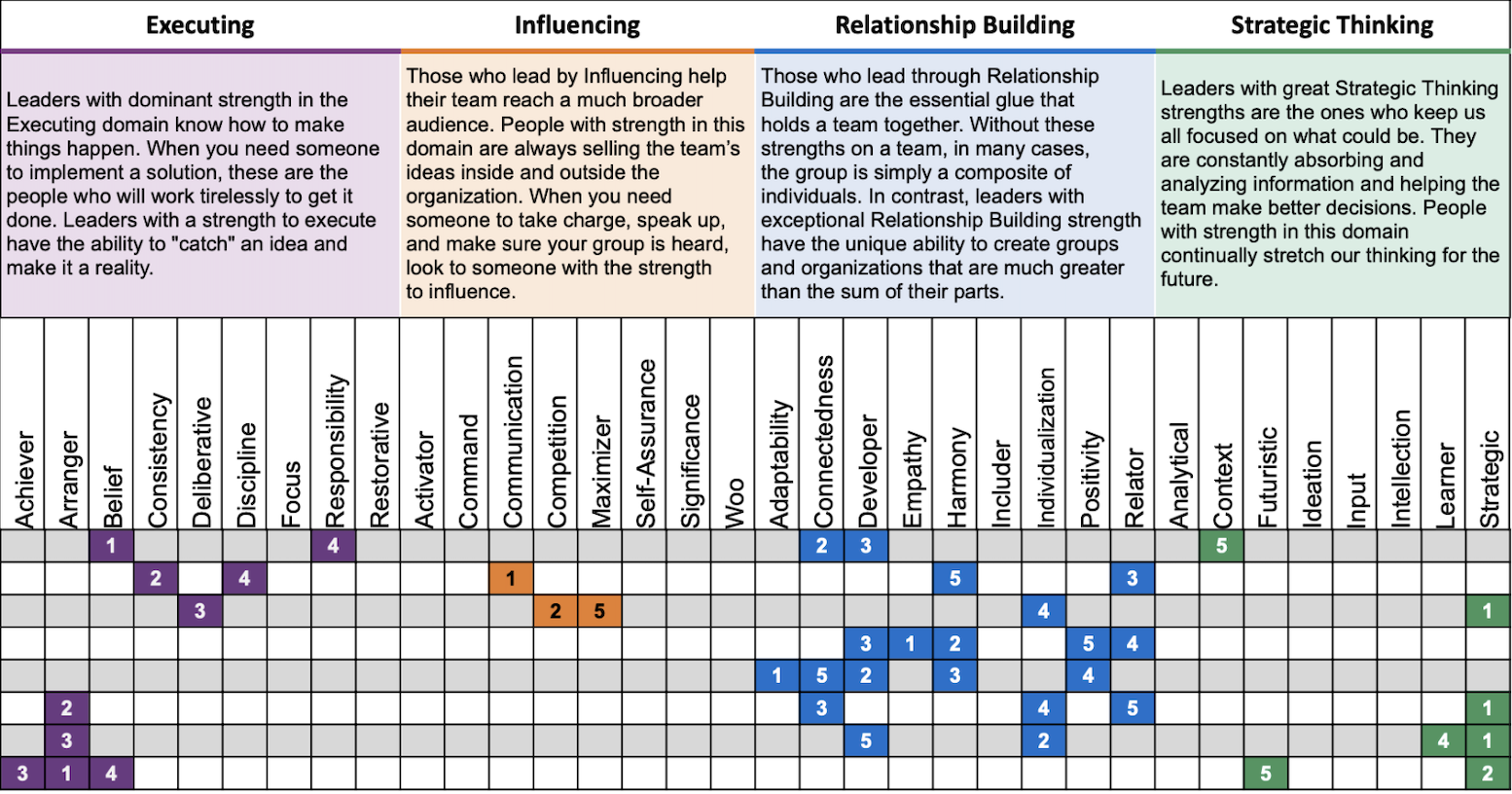Maximizing Team Potential with the CliftonStrengths Team Grid
As a Gallup Certified CliftonStrengths Coach, I’ve had the privilege of watching teams engage with their CliftonStrengths results in meaningful ways over the years. While individual strengths awareness is powerful, the real magic happens when teams come together to understand how their collective strengths shape the way they work. One of the most effective tools for this is the CliftonStrengths Team Strengths Grid, a visual representation of a team’s strengths across the four domains: Executing, Influencing, Relationship Building, and Strategic Thinking.
The Power of Seeing Strengths in One Place
Even on small teams, it can be difficult to remember everyone’s Top 5 strengths, let alone consider how they interact as a whole. The CliftonStrengths Team Strengths Grid acts as a shortcut, offering a clear snapshot of where strengths are concentrated and where there may be gaps. I’ve seen teams gain incredible insight simply by looking at their grid—recognizing patterns that explain how they naturally collaborate and identifying opportunities to lean on one another more intentionally
Identifying Strengths Gaps and Overuse Risks
A well-balanced team benefits from representation across all four domains, but in reality, most teams have areas of concentration. Some may be heavy in Relationship Building strengths but struggle with executing tasks efficiently. Others might be rich in Strategic Thinking but lack Influencing strengths to drive ideas forward. The grid helps teams recognize these trends, which allows them to adjust their approach.
Similarly, teams that heavily favor one domain can become too reliant on a particular way of thinking. A group that overwhelmingly leads with Executing strengths, for example, might charge forward without pausing for strategic planning or ensuring buy-in from others. Using the grid, teams can identify these tendencies and take steps to balance their approach by involving colleagues whose strengths complement their own.
Strengths-Based Collaboration in Action
When a team understands their strengths grid, they become more intentional about seeking input from those who think and operate differently. A team member who leads with Strategic Thinking might naturally turn to a colleague with high Relationship Building strengths when they need to understand how members of the team might react to an idea. Likewise, a team heavy in Influencing may recognize the need to involve someone with Executing strengths to ensure their vision turns into action.
A particular moment from a recent retreat stands out - a moment that perfectly captured the beauty (and occasional frustration) of working in a team of people with different strengths. For the sake of storytelling (and protecting identities), let’s call them Mark and Sarah.
Mark was the kind of team member who rarely answered a question with a simple yes or no. Instead, he provided background, setting the stage with details about past decisions, related conversations, and historical factors that had shaped the current situation. Meetings with him often took detours into backstory, sometimes to the visible frustration of his teammates - especially Sarah, who valued efficiency above all else.
During a session on recognizing strengths, something shifted. As the team reflected on their individual talents, a colleague pointed out that Mark had Context as one of his top strengths. Suddenly, his need to explain things wasn’t just an annoying habit - it was an asset. He wasn’t over-explaining to hear himself talk; he was anchoring decisions in history, ensuring the team didn’t repeat past mistakes.
Sarah, who had Achiever and other executing strengths in her top five, had a lightbulb moment. “That’s why you do that,” she said, half laughing, half exasperated. “I always assumed you were just overcomplicating things, but you’re actually making sure we’re not missing something important.”
Mark grinned. “And you’re always pushing forward so fast, I feel like I barely get to lay the foundation before we’re on to the next thing.”
It was a breakthrough. They didn’t need to change who they were - but they did need to recognize how their strengths played off each other and how, at times, the behaviors that can feel frustrating are often rooted in a colleague’s strength. Mark committed to checking in before launching into a deep dive, and Sarah acknowledged the value in slowing down to make time for context that might prevent mistakes.
This team’s realization was made possible by the ability to see - in chart form - how they each approach their work uniquely. Connecting their colleagues' behaviors to their strengths allowed the team to appreciate the value in differences - and find ways to work with them instead of against them.
Take the Next Step
If you want to see how your team can use their strengths more effectively, I highly recommend exploring the CliftonStrengths Team Strengths Grid. Even better, bring your team together to analyze your grid and discuss how to leverage strengths more intentionally. At transform.forward, we love helping teams unlock their full potential through strengths-based facilitation. If you’re interested in incorporating this tool into an upcoming team meeting, set up a consultation and we can discuss how we can help!
Your team’s greatest potential isn’t just in the strengths of individuals—it’s in the way those strengths come together. We'd love to help you maximize your team's potential.
CliftonStrengths Team Grid Example

